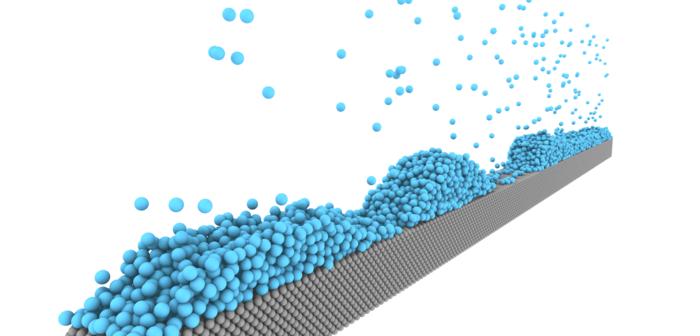| Oct 18, 2023 |
|
(Nanowerk News) Researchers have shown how the principles of rogue waves – huge 30-metre waves that arise unexpectedly in the ocean – can be applied on a nano scale, with dozens of applications from medicine to manufacturing.
|
Key Takeaways
|
|
Researchers at the University of Warwick have discovered how principles of rogue waves in the ocean can be applied to the nanoscale, opening up a new frontier in understanding liquid behavior.
The study offers groundbreaking methods for nano-manufacturing, including the potential for creating low-cost solar cell components through patterned liquid films.
The findings may also explain medical conditions like dry eye syndrome by examining how thin liquid layers, like tear films, rupture.
Advanced mathematical models and molecular simulations revealed how chaotic motion at the nanoscale can lead to rare ‘rogue nanowaves,’ similar to their large oceanic counterparts.
The research has broad applications across various industries, from medicine and manufacturing to potentially extending the shelf-life of emulsions in foods and paints.
|
 |
| MD simulation: The silver balls are solid particles and the blue balls are the fluid (liquid and vapour) particles. There is a liquid film sitting on a solid substrate, and there are waves at the surface. (Image: Jingbang Liu, University of Warwick)
|
The Research
|
|
The findings of the study have been published as open access in Physical Review Fluids (“Rogue nanowaves: A route to film rupture”).
|
|
Long considered to be a myth, rogue waves strike from comparably calm surroundings, smashing oil rigs and ships in their path. Unlike tsunamis, rogue waves form by the chance combination of smaller waves in the ocean, creating an event that is very rare.
|
|
There has been a lot of research into rogue waves in recent years but now, for the first time, scientists are showing how this can be applied on a much smaller scale – nanometrically. A nanometre is a million times smaller than the thickness of the page of a book. This is a completely new approach to the behaviour of liquids on a nanometric scale.
|
|
The holes and bumps caused by rogue waves can be manipulated to spontaneously produce patterns and structures for use in nano-manufacturing (manufacturing on a scale one-billionth of a metre). For example, patterns formed that rupture liquid films can be used to build micro-electronic circuits, which could be used in the production of low-cost components of solar cells. Furthermore, the behaviour of thin liquid layers could help to explain why millions of people worldwide suffer from dry eye. This occurs when the tear film covering the eye ruptures.
|
|
Through direct simulations of molecules and new mathematical models, the study led by the University of Warwick’s Mathematics Institute discovered how nanoscopic layers of liquid behave in counterintuitive ways. Whilst a spilt layer of coffee on a table may sit apparently motionless, at the nanoscale the chaotic motion of molecules creates random waves on a liquid’s surface. A rare event occurs when these waves conspire to create a large ‘rogue nanowave’ that bursts through the layer and creates a hole. The new theory explains both how and when this hole is formed, giving new insight into a previously unpredictable effect, by taking their large oceanic cousins as a mathematical blueprint.
|
|
The team of researchers is excited about the potential of this research in different industries; the applications are far-reaching.
|
|
Professor James Sprittles, Mathematics Institute, University of Warwick, said: “We were excited to discover that mathematical models originally developed for quantum physics and recently applied to predict rogue ocean waves are crucial for predicting the stability of nanoscopic layers of liquid.
|
|
“In future, we hope that the theory can be exploited to enable an array of nano-technologies, where manipulating when and how layers rupture is crucial. There might also be applications in related areas, such as the behaviour of emulsions, e.g. in foods or paints, where the stability of thin liquid films dictates their shelf-life.”
|


